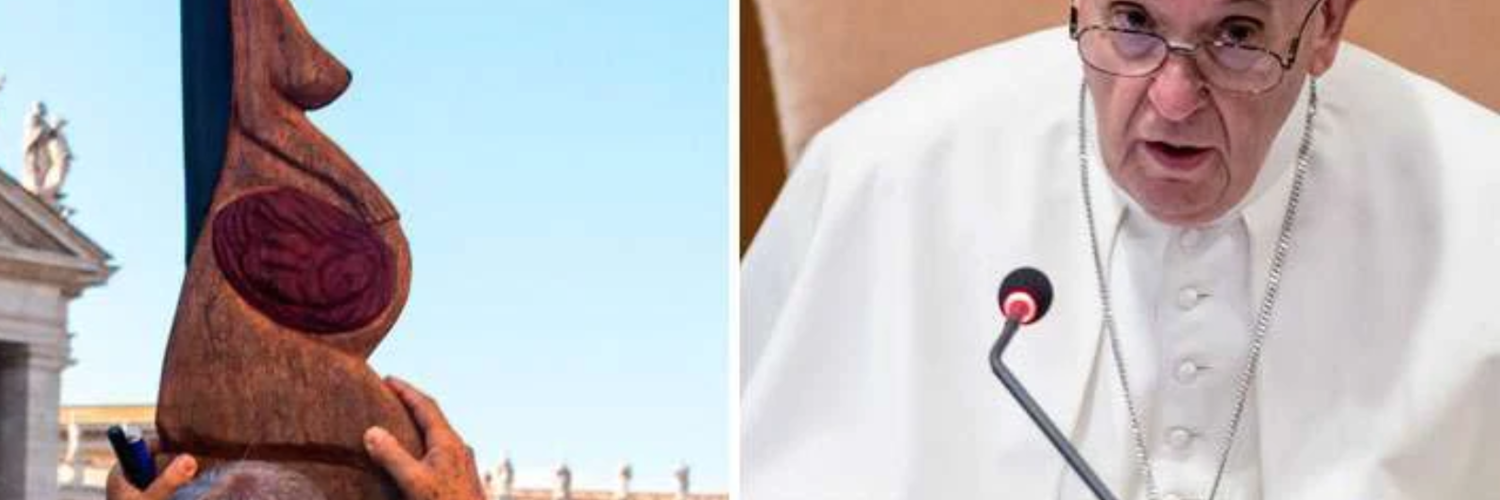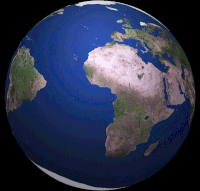
The question for today, after a whirlwind of Vatican news: When historians write about the Synod of Bishops for the Pan-Amazon region, will they call it the “Amazonian” synod or the “Pachamama” synod?
While the synod handled complex issues of Catholic tradition (ordaining married men) and the theology of holy orders (women entering the modern diaconate), it also veered into ancient questions about Christians being tempted to worship other deities. At this point, Catholic progressives and conservatives were arguing about the first item in the Ten Commandments, as in: “You shall have no other gods before me.”
But what about other gods that are, to use a progressive term, in “dialogue” with the Holy Trinity?
Journalists became involved in this debate for a simple reason: Vatican press aides kept sending mixed signals about the role of Pachamama statues in some synod rites. Some mainstream news reports — we will look at The New York Times — declined to name the woman portrayed in these statues.
That’s an interesting editorial stance, in light of remarks by Pope Francis. Here are some key sections of a report in The Catholic Herald:
The statues, which were identical carved images of a naked pregnant Amazonian woman, had been displayed in the Carmelite church of Santa Maria in Traspontina, close to the Vatican, and used in several events, rituals, and expression of spirituality taking place during the October 6-27 Amazonian synod.
The pope said they had been displayed in the church “without idolatrous intentions,” according to a transcript provided by the Vatican press office. …
Let’s keep reading:
According to the transcript provided by the Vatican, the pope referred to the statues as “Pachamama,” the name traditionally given to an Andean fertility goddess, which can be roughly translated as “Mother Earth.”
While it is unclear whether he was using it colloquially, the pope’s use of the term “Pachamama” will likely further ongoing debate regarding the exact nature of the statutes, and what they represent.
They had been described as representing “Our Lady of the Amazon,” and some journalists initially suggested they represented the Blessed Virgin Mary. Vatican spokesmen have said that they represent “life,” and are not religious symbols. …
It isn’t hard to find information about Pachamama. The Encyclopaedia Britannica offers this: “The Andean earth-mother figure, Pachamama (Pacha Mama), worshiped by the Peruvians, stands in sharp contrast to the sun religion of the Inca (the conquering lord of the Andes region).” There’s more:
The god of heaven in many areas is a partner of an earth deity. In such cases, other numina (spirits) are missing or are subject to one of the two as spirits of nature or ancestors. Myths depicting the heaven-earth partnership usually describe the foundations or origins of the partnership in terms of a separation of a primeval chaos into heaven and earth or in terms of a later separation of heaven and earth that originally lay close together, and they describe the impregnation of the earth by the seed of the god. …
It’s significant that Pope Francis used this term, when discussing the controversies that took place during the synod.
While it is unclear what he was saying about Pachamama, it’s hard to avoid the fact that the pope used the term. That’s an essential fact to include in news coverage, when quoting the views of Catholics on both sides of this debate.
With that in mind, consider this chunk of a major New York Times report on the synod, published after the remarks by Pope Francis:
Francis convened the bishops to find ways to defend the rights, natural resources and cultures of the 2.5 million indigenous people spread across the nine countries — Bolivia, Peru, Ecuador, Colombia, Venezuela, Brazil, Guyana, Suriname and French Guiana — that constitute the Amazon region. The bishops emphasized more respectful ways of “pastoral conversion” and urged the promotion of new churches “rooted in the cultures and traditions.”
But the meeting, which followed a broad survey of Catholics in the region, created high tension around the issue of blending Catholic and indigenous rites. Those tensions burst into the open on Monday with the theft and vandalism — technically unclaimed but apparently by Catholic traditionalists — of indigenous sculptures from a church being used by indigenous Catholics in Rome.

The key to the various synod debates, explained the Times team, was the pope’s “inclusive approach” that has “infuriated conservatives.”
What else did this piece have to say about the controversial statues?
At the beginning of the meeting, conservatives complained that Francis had presided over a prayer service with indigenous people that featured what they considered to be pagan idols of naked, pregnant women.
The conservative criticism grew more intense during the month, and before dawn on Monday, thieves stole the fertility statues from a church near St. Peter’s Basilica that had become a makeshift headquarters for the indigenous attendees, many of whom wore headdresses and traditional clothes mocked by the conservatives.
The key phrase is, “that featured what they [conservatives] considered to be pagan idols.”
Once again let me stress: It may be unclear what Pope Francis meant when he used the term “Pachamama” to describe these statues. However, it is clear that he used this term in a public statement. Why not note this basic fact in a report on the controversy? It would appear that, to the pope, there is no question as to the identity of the woman depicted in these images.
At that point, Catholics were debating a point in Catholic canon law. The Times piece did note this, sort of:
Even the former prefect for the church office on doctrine, Cardinal Gerhard Müller, seemed to take the side of the vandals.
“The great mistake was to bring the idols into the church, not to put them out,” he told the conservative American Catholic television channel EWTN. “Because according to the law of God himself, his First Commandment, idolatry is a grave sin. And not to mix them with the Christian liturgy.”
This is a significant question. Did some of the worship rites organized by the Amazonian synod bishops, or liturgists working with them, actually violate specific instructions in Catholic canon law?
If so, that would certainly be newsworthy. Here is an interesting online reference from canon lawyer Edward Peters, who teaches at Sacred Heart Major Seminary in Detroit. His goal is to consider the legality — in terms of Catholic law — of the actions of the activists who removed the Pachamama statues and tossed them in the Tiber.
This is complicated, but essential:
The Vatican having ruled out the possibility that the nude statues might represent the Virgin Mary or ‘Our Lady of the Amazon’, it is disputed whether the figurines portray the Amazon pagan goddess Pachamama or (at least per a handful of Vaticanisti) merely some vague “life force”. It is not for me to opine on who or what the objects actually represent and if someone wants to argue that chanting to and bowing before figurines of naked women does not count as worshiping strange gods, well, who am I to say?
Note that this piece was posted on Oct. 22 — before the statement by Pope Francis that used the term “Pachamama” to describe the images.
Back to the Peters commentary:
… A fuller assessment of the act of these two men does not rest solely on whether the figures are demonic or merely faddish. Canon 1210, addressing the dignity of Catholic holy places in general, states: “Only those things which serve the exercise or promotion of worship, piety, or religion are permitted in a sacred place; anything not consonant with the holiness of the place is forbidden…” And Canon 1220 § 1, addressing churches specifically, states: “All those responsible are to take care that in churches such cleanliness and beauty are preserved as befit a house of God and that whatever is inappropriate to the holiness of the place is excluded.”
These canons, in my view, do not simply preclude the placement of obviously demonic or pagan artifacts in our churches, but rather, require those in charge of sacred places to set up objects that are positively conducive to Christian prayer and worship.
Here’s the question that remains unanswered: Were theologians linked to the Amazonian synod arguing that it was appropriate to use images of the Earth Mother/Pachamama as a new way of symbolizing Catholic traditions associated with the veneration (not worship) of the Virgin Mary?
That’s an important question. What’s the answer? There is no way to know, since Vatican officials have declined to offer clarity.
Yes, conservative Catholics are concerned about the use of Pachamama images in Vatican sanctioned worship rites. But, more than anything else, they want to know what was being said — in terms of Catholic theology — during these rites.
Here is a typical passage, draw from an essay by Christopher R. Altieri in the conservative Catholic World Report. It focuses on one of the first rites (see video at the top of this post) staged during the Amazonian synod.
Indigenous participants in a tree-planting ceremony gathered around a mat — a mandala — representing the Amazon region and its “water, earth, seeds, and martyrs”, knelt, were led by a woman in native ceremonial dress in something that looked for all the world like prayer of some sort, and bowed low to the ground, facing the figures of two pregnant women in a boat at the center of the mat, on which the apparent leader of the ceremony and other participants had placed things that looked very much like a symbolic offering.
The leader took the bowl she had been carrying, and approached Pope Francis. She took a ring from the bowl and put it on his finger, then she made the Sign of the Cross and received Pope Francis’s blessing under the same Sign. Another participant offered Pope Francis the larger of the two images of pregnant women, as a voice can be heard declaring “Our Lady of the Amazon!” or “She is Our Lady of Amazonia!” Another fellow gave Pope Francis a necklace, and received his blessing, also under the Sign of the Cross.
A single sentence would have sufficed: one to say that the figures of the women represented Our Lady and her cousin, St Elizabeth, at the Visitation; and that the posture adopted, while admittedly unusual — very much so, and possibly shocking to Western sensibilities — is quite normal and very much a default attitude of veneration among the peoples of the Amazon. That sentence would have dealt with the perplexity and turned a tinderbox into a teachable moment. With a little advance notice and preparation, this whole business would have gone away before it started.
At this point, the tinderbox remains. This is true, even if some mainstream reporters hesitate to cover the facts of the debates — papal statements, for example — that are taking place.










